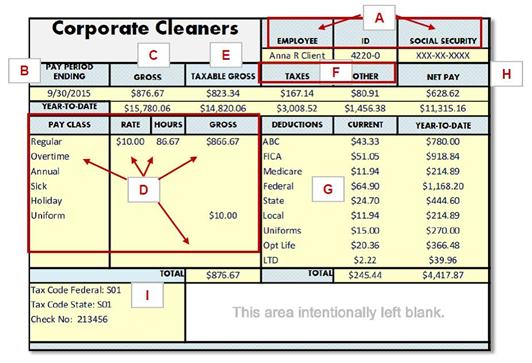Did you know that there is no standard form that employers must use to report pay information to their employees? Although there is a minimum amount of information that must be included, each company chooses its own format, abbreviations, and level of detail in reporting employee pay information. Click Understanding Your Pay Statement to download the worksheet which will help you sort through your own pay statement. In the meantime, let's look at an example.
This is Anna R. Client's pay statement. We've identified key sections of her pay statement and made an analysis of each below.

(A) Employee information. This section shows Anna's name, employee identification number, and social security number. Most employers will not show the complete number as a safety precaution. Not all companies assign ID numbers and some break down the location, department, and position of the employee.
(B) Pay period end. This is the date upon which the reported payroll period ends. Anna's statement reflects all compensation that she earned during the bimonthly period ending on this date.
(C) Gross. This is the total of all earnings types that were paid to Anna during this period and year to date. They are further broken down in D.
(D) Pay details. This section shows the types of pay and the hourly rate, number of hours, and gross amount of compensation for each earnings type that Anna's employer offers; Anna only earned wages from one category, regular, during this period, but her employer offers overtime, annual, sick, and holiday pay. Anna also received a uniform allowance because she must wear the company uniform when working. Depending on how an employee earns paid time off, including annual, vacation, personal, sick, etc., the company may also report leave hours used, earned, and total available (sometimes referred to as 'banked.')
(E) Taxable gross. This is the total amount of gross pay that is taxable for federal income tax purposes. So, why is less of Anna's gross income taxable? In general, earnings used for certain expenses are either not subject to federal taxes or may be deferred to a later time. Anna doesn’t have to pay federal income taxes (or social security taxes!) on money that is used for health care expenses. She also doesn’t have to pay federal income taxes on the uniform allowance that she receives. If Anna would make a contribution to a retirement plan that too would reduce her taxable gross income, but she would have to pay income taxes on it later, when she takes it out at retirement. These deductions are called ‘pre-tax’ deductions. We’ll talk more about pre-tax deductions in the Are Employee Benefits Taxable? section.
(F) Taxes and Other withholdings. These boxes show total taxes withheld from Anna's pay and other deductions which are detailed in G.
G) Deductions detail. This section lists each deduction that has been withheld from Anna's pay. She has federal (I), state, and local income taxes withheld, along with social security (abbreviated FICA) and Medicare taxes. Anna pays health insurance premiums (abbreviated ABC for the plan), uniform expenses, optional life insurance (abbreviated Opt Life), and long-term disability insurance premiums (abbreviated LTD).*
(H) Net pay. This is the net amount of pay (or 'take-home' pay) that you receive after all tax and deduction amounts are subtracted from your total gross pay.
(I) Other notes. Anna's statement shows the tax withholding allowances that she submitted on her (IRS Form W-4 Allowance for Employee Withholding Certificate); these allowances determine the amount of federal income taxes her employer should withhold. (We’ll talk more about withholding in the Adjust Withholding page of the Check Taxes section.) This section also shows the check number for Anna's pay. Many formats separate tax status and the check number or direct deposit information. Other notes may also include important employee notices, announcements, or benefit information.
We should all check our pay statements frequently for errors, omissions, and necessary changes.
Next up: More Than Just a Paycheck
*Side Bar: When in doubt, ask questions. Anna noticed the deduction for the optional life insurance and questioned why it was so high. She followed up with her human resources department and discovered that when she was hired several years prior, she elected for $50,000 of optional whole life insurance. Anna researched life insurance in the Protect Your Potential section and spoke with the group benefits agent about the pros and cons of the policy for her situation. She decided that term insurance would better fit needs, and would only cost her $1.65 per pay period for the same benefit amount. Anna made changes her optional life insurance to the term policy and is no longer paying for a benefit that doesn't fit her need.

